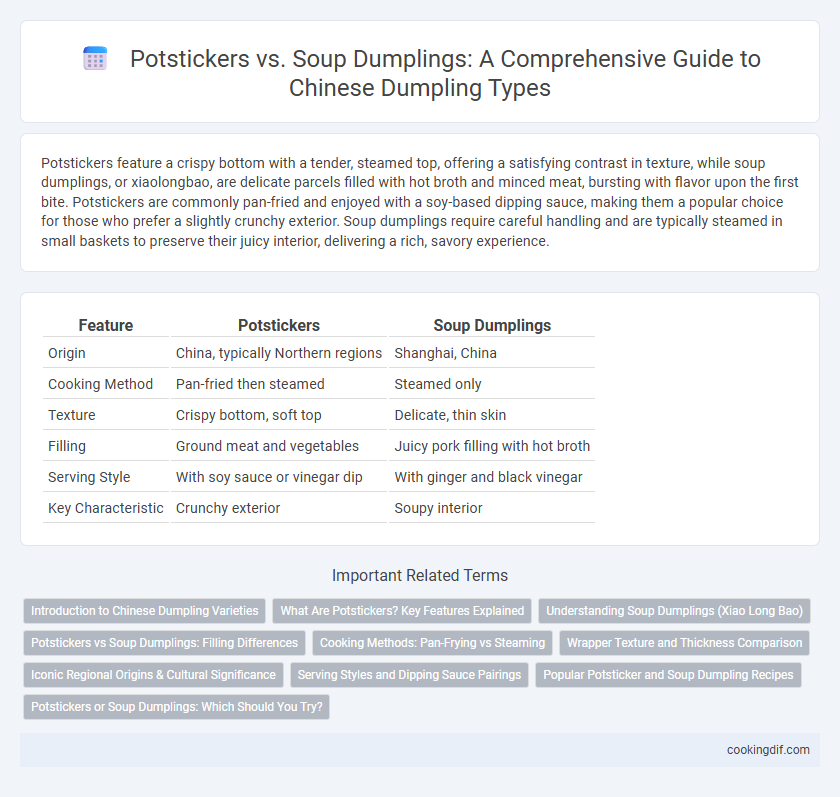Potstickers feature a crispy bottom with a tender, steamed top, offering a satisfying contrast in texture, while soup dumplings, or xiaolongbao, are delicate parcels filled with hot broth and minced meat, bursting with flavor upon the first bite. Potstickers are commonly pan-fried and enjoyed with a soy-based dipping sauce, making them a popular choice for those who prefer a slightly crunchy exterior. Soup dumplings require careful handling and are typically steamed in small baskets to preserve their juicy interior, delivering a rich, savory experience.
Table of Comparison
| Feature | Potstickers | Soup Dumplings |
|---|---|---|
| Origin | China, typically Northern regions | Shanghai, China |
| Cooking Method | Pan-fried then steamed | Steamed only |
| Texture | Crispy bottom, soft top | Delicate, thin skin |
| Filling | Ground meat and vegetables | Juicy pork filling with hot broth |
| Serving Style | With soy sauce or vinegar dip | With ginger and black vinegar |
| Key Characteristic | Crunchy exterior | Soupy interior |
Introduction to Chinese Dumpling Varieties
Potstickers, also known as guotie, feature a crispy bottom with a pan-fried texture and juicy filling, typically consisting of pork, cabbage, and green onions. Soup dumplings, or xiaolongbao, are steamed with a thin, delicate skin encasing hot, flavorful broth alongside minced pork or seafood. Both varieties highlight the diverse techniques and regional flavors central to Chinese dumpling cuisine.
What Are Potstickers? Key Features Explained
Potstickers are a popular type of Chinese dumpling characterized by their thin, wheat flour wrapper and a filling typically made of ground pork, cabbage, and seasonings. They are pan-fried to achieve a crispy bottom and steamed to ensure the top remains tender and juicy, giving a unique texture contrast. Unlike soup dumplings (xiaolongbao), potstickers do not contain a liquid broth inside and are served with dipping sauces like soy sauce or vinegar.
Understanding Soup Dumplings (Xiao Long Bao)
Soup dumplings, also known as Xiao Long Bao, are distinguished by their delicate, thin skin that encases a flavorful broth along with seasoned pork filling, creating a unique, soupy bite unlike potstickers which are pan-fried and have a thicker, chewier exterior. Originating from the Jiangnan region of China, Xiao Long Bao requires a skilled steaming process to maintain the soup inside without breaking the wrapper, highlighting craftsmanship in Chinese dumpling making. Known for their juicy, melt-in-the-mouth texture and served traditionally with black vinegar and ginger, soup dumplings emphasize a balance of flavors and textures central to authentic Chinese cuisine.
Potstickers vs Soup Dumplings: Filling Differences
Potstickers typically feature a mixture of ground pork, cabbage, garlic, and ginger with a slightly thicker, pan-fried wrapper that provides a crispy texture. Soup dumplings, or xiaolongbao, contain a gelatinized pork broth that melts into soup upon steaming, combined with finely minced pork filling and a thin, delicate wrapper. The primary filling difference lies in potstickers' solid, stir-fried ingredients versus soup dumplings' liquid broth-infused interior.
Cooking Methods: Pan-Frying vs Steaming
Potstickers are typically cooked using pan-frying, creating a crispy bottom while the top remains tender, which enhances their texture contrast. In contrast, soup dumplings are steamed, preserving their delicate, thin wrappers and the hot, flavorful broth inside. The cooking method significantly affects the dumpling's texture and eating experience, with potstickers offering a crunchy bite and soup dumplings delivering a juicy, soupy interior.
Wrapper Texture and Thickness Comparison
Potstickers feature a thicker, chewier wrapper that crisps up when pan-fried, providing a satisfying contrast between a golden crust and a tender interior. Soup dumplings, or xiaolongbao, have a delicate, thinner skin designed to hold flavorful broth inside without breaking, offering a soft, almost translucent texture. The wrapper thickness directly impacts the dumpling's cooking method and mouthfeel, with potstickers favoring durability and crunch, while soup dumplings prioritize subtlety and juiciness.
Iconic Regional Origins & Cultural Significance
Potstickers, originating from Northern China, particularly Beijing, are pan-fried dumplings known for their crispy bottoms and tender steamed tops, symbolizing traditional Northern Chinese culinary techniques. In contrast, soup dumplings, or Xiaolongbao, hail from Jiangnan region, especially Shanghai, famous for their thin skin encasing flavorful broth and meat, reflecting the delicate craftsmanship of Eastern Chinese cuisine. Both dumpling types hold significant cultural value, representing regional identities and festive traditions in Chinese gastronomy.
Serving Styles and Dipping Sauce Pairings
Potstickers are pan-fried dumplings with a crispy bottom and tender top, typically served on a plate with dipping sauces like soy sauce, black vinegar, and chili oil. Soup dumplings, or xiao long bao, are steamed and filled with hot broth and meat, usually presented in a bamboo steaming basket and paired with a light soy-vinegar dipping sauce with ginger slices. Each type offers a distinct texture experience: potstickers balance crunch and chewiness, while soup dumplings provide a delicate burst of savory broth with every bite.
Popular Potsticker and Soup Dumpling Recipes
Potstickers, known for their crispy bottom and tender steamed top, are often filled with pork, cabbage, and ginger, delivering a savory and crunchy texture widely enjoyed in popular recipes across Chinese cuisine. Soup dumplings, or xiaolongbao, feature delicate, thin wrappers encasing flavorful broth and minced pork, requiring precise steaming techniques to preserve their juicy interior. Both potstickers and soup dumplings represent iconic Chinese dumpling varieties, celebrated for distinct cooking methods and rich flavor profiles in authentic recipes.
Potstickers or Soup Dumplings: Which Should You Try?
Potstickers offer a crispy texture with a savory, pan-fried exterior and a juicy pork or vegetable filling, making them ideal for those who enjoy a balance of crunch and tenderness. Soup dumplings, known as xiao long bao, feature delicate, thin wrappers encasing flavorful broth and meat, providing a unique, soupy bite that highlights intricate steaming techniques. Choosing between potstickers and soup dumplings depends on whether you prefer a satisfying crisp or a luscious broth-filled experience in traditional Chinese cuisine.
Potstickers vs Soup dumplings for Chinese dumpling types Infographic

 cookingdif.com
cookingdif.com